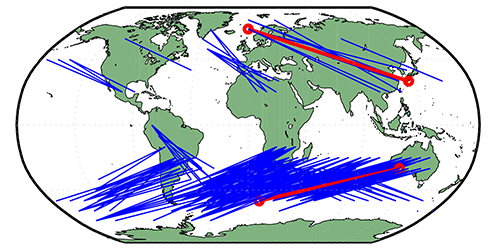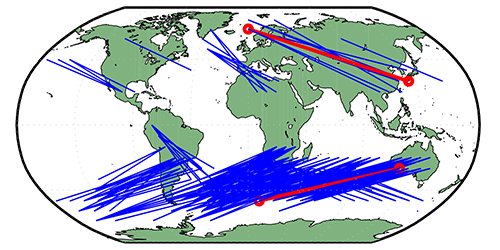Finding Climate Teleconnection Paths
Although the periodic climatic phenomenon known as El Niño originates over the Pacific, it can affect climates all over the globe, creating warmer winters in the US, droughts in Indonesia or cold spells in northern Europe. It is an example of a climate “teleconnection,” a link that intertwines distant geographic regions. Identifying possible teleconnections and what causes them is essential for accurate climate modeling. Dong Zhou at Bar-Ilan University, Israel, and colleagues now propose a way to extract teleconnections, and the paths along which they propagate, from a statistical analysis of global climate datasets.
The authors model the climate system as a network in which geographic locations are represented by nodes connected by links whose “weights” depend on correlations between the nodes. Using 63 years (1948–2010) of data on daily air temperatures from around the world, they were able to calculate the weight of each network link. From these weights, they extracted the direct-link paths through the network along which correlations travel. They found over 200 long-distance teleconnections and suggest that a large fraction of them are due to Rossby waves— high-altitude airwaves that redistribute energy across the planet.
Zhou and his colleagues analyzed three teleconnections corresponding to well-known climate correlations between the Norwegian Sea and southern Japan, the Drake Passage and western Australia, and the South Pacific and northwestern South America. For the three cases, they showed that the paths linking the correlated regions could be related to the atmospheric processes causing the teleconnections: winds induced by the so-called North Atlantic Oscillations, Rossby waves, and Humboldt currents, respectively.
This research is published in Physical Review Letters.
–Matteo Rini





